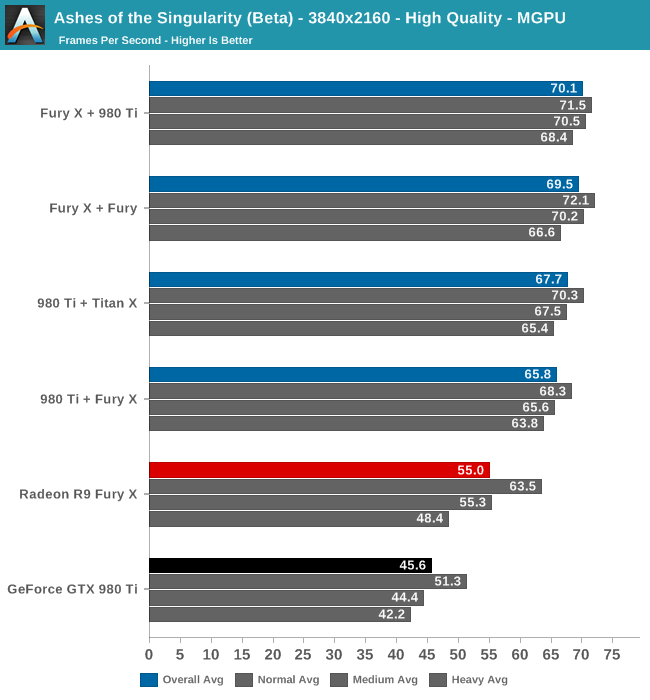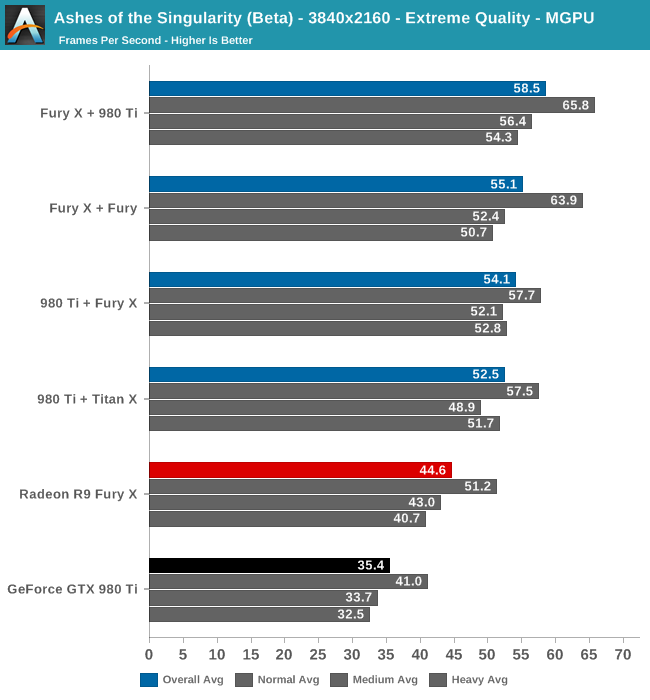Ashes of the Singularity Revisited: A Beta Look at DirectX 12 & Asynchronous Shading
by Daniel Williams & Ryan Smith on February 24, 2016 1:00 PM ESTDirectX 12 Multi-GPU Performance
Shifting gears, let’s take a look at multi-GPU performance on the latest Ashes beta. The focus of our previous article, Ashes’ support for DX12 explicit multi-GPU makes it the first game to support the ability to pair up RTG and NVIDIA GPUs in an AFR setup. Like traditional same-vendor AFR configurations, Ashes’ AFR setup works best when both GPUs are similar in performance, so although this technology does allow for some unusual cross-vendor comparisons, it does not (yet) benefit from pairing up GPUs that widely differ in performance, such as a last-generation video card with a current-generation video card. None the less, running a Radeon and a GeForce card together is an interesting sight, if only for the sheer audacity of it.
Meanwhile as a result of the significant performance optimizations between the last beta build and this latest build, this has also had an equally significant knock-on effect on mutli-GPU performance as compared to the last time we looked at the game.

Even at 4K a pair of GPUs ends up being almost too much at Ashes’ High quality setting. All four multi-GPU configurations are over 60fps, with the fastest Fury X + 980 Ti configuration nudging past 70fps. Meanwhile the lead over our two fastest single-GPU configurations is not especially great, particularly compared to the Fury X, with the Fury X + 980 Ti configuration only coming in 15fps (27%) faster than a single GPU. The all-NVIDIA comparison does fare better in this regard, but only because of GTX 980 Ti’s lower initial performance.
Digging deeper, what we find is that even at 4K we’re actually CPU limited according to the benchmark data. Across all four multi-GPU configurations, our hex-core overclocked Core i7-4960X can only setup frames at roughly 70fps, versus 100fps+ for a single-GPU configuration.

Top: Fury X. Bottom: Fury X + 980 Ti
The increased CPU load from utilizing multi-GPU is to be expected, as the CPU now needs to spend time synchronizing the GPUs and waiting on them to transfer data between each other. However dropping to 70fps means that Ashes has become a surprisingly heavy CPU test as well, and that 4K at high quality alone isn’t enough to max out our dual GPU configurations.

Cranking up the quality setting to Extreme finally gives our dual-GPU configurations enough of a workload to back off from the CPU performance cap. Once again the fastest configuration is the Fury X + 980 Ti, which lands just short of 60fps, followed by the Fury X + Fury configuration at 55.1fps. In our first look at Ashes multi-GPU scaling we found that having a Fury X card as the lead card resulted in better performance, and this has not changed for the newest beta. The Fury continues to be faster at reading data off of other cards. Still, the gap between the Fury X + 980 Ti configuration and the 980 Ti + Fury X configuration has closed some as compared to last time, and now stands at 11%.
Backing off from the CPU limit has also put the multi-GPU configurations well ahead of the single-GPU configurations. We’re now looking at upwards of a 65% performance boost versus a single GTX 980, and a smaller 31% performance boost versus a single Fury X. These are smaller gains for multi-GPU configurations than we first saw last year, but it’s also very much a consequence of Ashes’ improved performance across the board. Though we didn’t have time to test it, Ashes does have one higher quality setting – Crazy – which may drive a bit of a larger wedge between the multi-GPU configurations and the Fury X, though the overhead of synchronization will always present a roadblock.












153 Comments
View All Comments
permastoned - Sunday, February 28, 2016 - link
Wasn't trolling - there are other metrics that show the case; for you to imply that 3dmark isn't valid is just silly: http://wccftech.com/amd-r9-290x-fast-titan-dx12-en...Another thing; what's the deal with all these fanboys? There is no benefit to being a fanboy of either AMD or Nvidia, it is just going to cause you problems because it may cause you to buy based on brand, rather than on performance per dollar, which is the factor that actually matters. At different price ranges different brands are better - e.g top end, a 980Ti is better than a fury X, however if you are looking in the price bracket below, and want buy a 980, you will get better performance and performance per dollar from a standard fury.
Being a fanboy will blind you from accepting the truth when the tides shift and the tables eventually turn. It helps you in no way at all, it disadvantages you in many. It also causes you to get angry on forums for no reason, and call people 'trolls' when they are stating facts.
Soulwager - Sunday, March 20, 2016 - link
Poorly how, exactly? It looks to me like DX12 is just removing a bottleneck for AMD that Nvidia already fixed in DX11. It would be more correct to say that AMD has poor DX11 performance compared to Maxwell, and neither are constrained by driver overhead in DX12.SunLord - Wednesday, February 24, 2016 - link
DX12 by desing will slightly favor older AMD designs simply because of the design decisions that AMD made compared to Nvidia with regards DX11 that are paying off with Dx12 while Nvidia benefited from it with DX11 games which is why they own around 80% or so of the gaming GPU market. How much of an impact this will be depends on the game just like how it is with DX11 games some do better on AMD some will be better on Nvidia.anubis44 - Thursday, February 25, 2016 - link
If results like these continue with other DX12 games, nVidia's going to be the one with only 20% in a matter of months.althaz - Thursday, February 25, 2016 - link
Even in generation where AMD/ATI have been dominant in terms of performance and value, they've still not really dominated in sales.Just like even when AMD's CPUs were offering twice the performance per watt and cheaper performance per dollar, they still sold less than Intel.
Doing it for a short time isn't enough, you have to do it for *years* to get a lead like nVidia has.
Firstly you have to overturn brand-loyalty from complete morons (aka everybody with any brand loyalty to any company, these are corporations that only care about the contents of your wallet, make rational choices). That will happen only a small percentage of people at a time. So you have to maintain a pretty serious lead for a long time to do it.
AMD did manage to do it in the enthusiast space with CPUs, but (arguably due to Intel being dodgy pricks) they didn't quite turn that into mainstream market dominance. Which sucks for them, because they absolutely deserved it.
So even if AMD maintains this DX12 lead for the rest of the year and all of the next, they'll still sell less GPUs than nVidia will in that time. But if they can do it for another year after that, *then* would they be likely to start winning the GPU war.
Personally, I don't care a lot. I hope AMD do better because they are losing and competition is good. However, I will make my next purchasing decision on performance and price, nothing else.
permastoned - Sunday, February 28, 2016 - link
Wasn't trolling - there are other metrics that show the case; for you to imply that 3dmark isn't valid is just silly: http://wccftech.com/amd-r9-290x-fast-titan-dx12-en...2 points = trend.
Another thing; what's the deal with all these fanboys? There is no benefit to being a fanboy of either AMD or Nvidia, it is just going to cause you problems because it may cause you to buy based on brand, rather than on performance per dollar, which is the factor that actually matters. At different price ranges different brands are better - e.g top end, a 980Ti is better than a fury X, however if you are looking in the price bracket below, and want buy a 980, you will get better performance and performance per dollar from a standard fury.
Being a fanboy will blind you from accepting the truth when the tides shift and the tables eventually turn. It helps you in no way at all, it disadvantages you in many. It also causes you to get angry on forums for no reason, and call people 'trolls' when they are stating facts.
Continuity28 - Wednesday, February 24, 2016 - link
By the time DX12 becomes commonplace, I'm sure they will have cards that were built for DX12.It makes a lot of sense to design your cards around what will be most useful today, not years in the future when people are replacing their cards anyways. Does it really matter if AMD's DX12 performance is better when it isn't relevant, when their DX11 performance is worse when it is relevant?
Senti - Wednesday, February 24, 2016 - link
Indeed it makes much sense to build cards exactly for today so people would be forced to buy new hardware next year to have decent performance. From certain green point of view. But many people are actually hoping that their brand new mid-top card would last with decent performance at least some years.cmdrdredd - Wednesday, February 24, 2016 - link
Hardware performance for new APIs is always weak with first gen products. That isn't changing here. When there are many DX12 titles out and new cards are out there, you'll see that people don't want to try playing with their old cards and will be buying new. That's how it works.ToTTenTranz - Wednesday, February 24, 2016 - link
"Hardware performance for new APIs is always weak with first gen products."Except that doesn't seem to be the case with 2012's Radeon line.